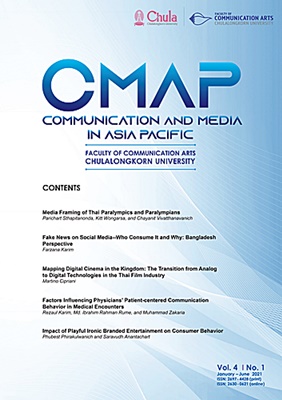Mapping Digital Cinema in the Kingdom: The Transition from Analog to Digital Technologies in the Thai Film Industry
Main Article Content
Abstract
This article aims to map and analyze the processes that lead to the conversion from analog machineries to digital technologies within the Thai film industry during the decades 2010-2020. The infrastructures and practices that define Thailand's contemporary digital film industry result from a series of transformations that occurred when analog film technologies were disposed of in favor of digital technologies. The first part of the research analyzes the role of local audiovisual infrastructures and leading players involved in the film industry, while the second and conclusive part of the study focuses on the disruptive changes that occurred after the digital turn and underlines the main consequences of it. Ultimately this study points out how the digital turn has been mainly managed by the local oligopolies of the exhibition sector and was caused by introducing a specific technology: DCP or Digital Cinema Package.
Article Details
References
Benedict, A., & Mendiones, R. (1985). In the mirror: Literature and politics in Siam in the American Era. Bangkok: D.K. Book House.
Bijker, W. (1997). Of bicycles, bakerites and bulbs: Toward a theory of Socio-technical change. Boston, MA: MIT Press.
Boonyaketmala, B. (1992). The rise and fall of the film industry in Thailand, 1897-1992. East-West Film Journal (Vol. 6). Honolulu, HI: East-West Center.
Chaiworaporn, A. (2017). Royalty shapes early Thai film culture. In N. Deocampo (Ed.). Early cinema in Asia. Bloomington, IN: Indiana University Press.
Chaiworaporn, A. (2000). Thai cinema since 1970. In D. Hanan (Ed.). Film in South East Asia: Views from the region--Essays on film in ten South East Asia-Pacific countries. Manila, The Philippines: SEAPAVAA.
Christie, C. J. (1996). A modern history of Southeast Asia: Decolonization, nationalism and separatism. London, UK: Tauris Academic Studies London.
Day, T., & Liem, M. (2010). Cultures at war: The cold war and Cultural expression in Southeast Asia. Ithaca, NY: Cornell University Press.
Dissanayake, W. (1994). Colonialism and nationalism in Asian cinema. Bloomington, IN: Indiana University Press.
Edmondson, R. (2016). Audiovisual archiving: Philosophy and principles (3rd ed.). Paris, France: UNESCO.
Elsaesser, T. (2016). Film history as media archaeology. Amsterdam, The Netherlands: Amsterdam University Press.
Enticknap, L. (2013). Film restoration: The technology and culture of audiovisual heritage. London, UK: Palgrave McMillan.
Frick, C. (2011). Saving cinema: The politics of preservation. Oxford, UK: Oxford University Press.
Fossati, G. (2018). From grain to pixel: The archival life of film in transition (3rd rev. ed.). Amsterdam, The Netherlands: Amsterdam University Press.
Fossati, G., & Van den Oever, A. (2016). Exposing the film apparatus: The film archive as a research Laboratory. Amsterdam, The Netherlands: Amsterdam University Press.
Hamilton, A. (1993a). Cinema and the nation: Dilemmas of representation in Thailand. East-West Film Journal, 7. Honolulu, HI: East-West Center.
Hamilton, A. (1993b). Video crackdown, censorship and cultural consequences in Thailand. Chicago, IL: University of Chicago Press.
Hanan, D. (Ed.). (2001). Film in Southeast Asia: Views from the Region--Essays on film in ten Southeast Asia-Pacific countries. Manila, The Philippines: SEAPAVAA.
Herrera, A. (2015). Thai 16 mm. cinema: The rise of a popular cinematic culture In Thailand 1945 -1970. Rian Thai International Journal of Thai Studies, 8.
Horak, J. (2007). The gap between 1 and 0, digital video and the omission of film history. The Spectator, 27(1).
Ingawanij, M. A. (2006). Hyperbolic heritage: Bourgeois spectatorship and contemporary Thai cinema. Doctoral dissertation, University of London, London, UK.
Ingawanij, M. A. (2018). Itinerant cinematic practices in and around Thailand during the Cold War. In Southeast of now: Directions in contemporary and modern art in Asia (Vol. 2). Singapore: NUS Press.
Lockard, C. A. (2009). Southeast Asia in world history. Oxford, UK: Oxford University Press.
Osborne, M. (2013). Southeast Asia: An introductory history. Sydney, Australia: Allen & Unwin.
National Film Preservation Foundation. (2004). The film preservation guide: The basics for archives, libraries, and museums. San Francisco, CA: Author.
Ponzanesi, S., & Waller, M. (2012). Postcolonial cinema studies Milton Park, UK: Routledge.
Reynolds, B. E. (2005). Thailand's secret war: The free Thai, OSS, and SOE during World War II. Cambridge, UK: Cambridge University Press.
Scot, B. (2002). Woman, man, Bangkok: Love, sex, and popular culture in Thailand. Lanham, MD: Rowman & Littlefield.
Sukwong, D., & Suwannapak, S. (2001). A century of Thai cinema. Bangkok, Thailand: River Books.
Sungsri, P. (2008). Thai national cinema: The three potent signifiers of Thai identity, nation, religion, and monarchy, their relationship and influence in Thai national cinema. London, UK: VDM Verlag Dr. Mueller EK.
Wyatt, D. K. (2003). Thailand: A short history. Chiang Mai, Thailand: Silkworm Books.
Tarling, N. (Ed.). (2008). The Cambridge history of Southeast Asia, Volume II. Cambridge, UK: Cambridge University Press.
Uabumrumjit, C. (2000). Cinema in Thailand: 1897 to 1970. In D. Hanan (Ed.). Film in South East Asia: Views from the region--Essays on film in ten South East Asia-Pacific countries. Manila, The Philippines: SEAPAVAA.
Wiwatsinudom, R. (2010). International seminar and Screening of Thai cinema. Bangkok, Thailand: Faculty of Communication Arts, Chulalongkorn University, Thailand.
Walls, W. D. (2009). The market of motion pictures in Thailand: Rank, revenue and survival at the box office. Calgary, Canada: Calgary University Press.


